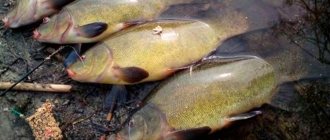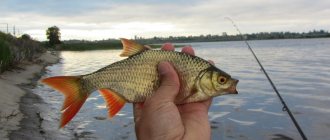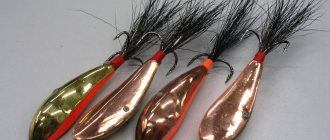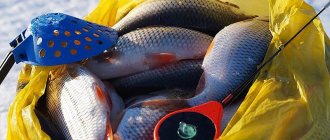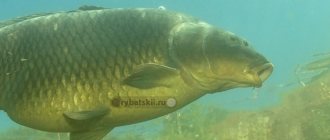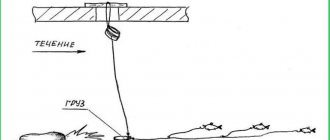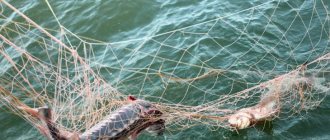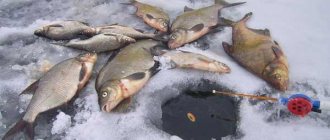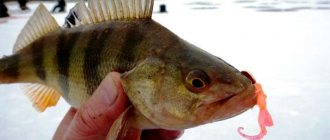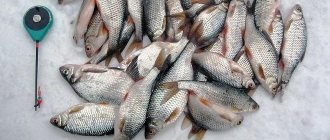What to fish with
If there is such a tackle that can be used to catch tench in winter, it is a jig. Previously, there were only small rods, and therefore the fish caught on them were small. Now every angler has the opportunity to show off his catch, as such baits have become larger. They are silver in color and take a horizontal position in the water, which gives a very comfortable hook position.
One of the features that can be noted is the large coil. The thing is that tench lives at great depths, so there should be enough fishing line. Accordingly, the coil must be rather large.
It is important that the rod is durable. The tench begins to kick when you lead it closer to the surface. Due to this, the risk of rod breakage increases. The same can be said about the fishing line, it must also be strong. Well, if there is a nod, it will become an additional assistant for the fisherman.
We also recommend reading:
Overhead hooks for fishing: description, classification, reviews Catching bream in April 2021 So tasty and so different: hominy made from corn grits Catching pike perch with a dead fish
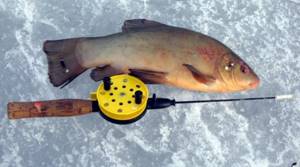
Baiting the length of the tench and choosing a place for winter fishing
Often on the first ice there is no need to guess where the strip of grass along the shore was in the summer. The grass simply has not yet fallen to the bottom and is clearly visible under the transparent ice, or has even frozen into the ringing ice, exposing its leaves on top. This happens with hornwort, not to mention reeds.
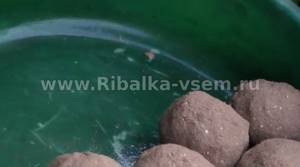
The border of this strip of vegetation, or even better, a window among it, will be the place where you can expect a tench bite. If you are seriously preparing for line fishing, then you must first feed the fishing spot for several days. The bait is thrown in the form of voluminous balls, crumbly, but not disintegrating in the water column. The bait should settle in one specific place, preferably clean, but among underwater vegetation. Such places are created by the fisherman himself, but some effort will be required to prepare the fishing site. At first there is a window among the grass, if it is visible to the eye. Or on an already snow-covered oxbow, thickets of grass are found by dropping a large tee with a load to the bottom. Then you need to find the edge, which is also on the oxbow, since this is an old river bed with all the features inherent in rivers. In the chosen place, even if it is overgrown with grass, you need to create a “table” for the tench. To do this, a tee with a weight is repeatedly lowered into the hole, and the bottom is cleared of grass with this improvised “cat” as much as possible. The next step will be adding sand to the bottom under the hole. Not much sand is required for the rather limited space under the hole, but the effect will be much better than catching tench at random.
On the finished dining “table” for tench, it is necessary to lower the bait for several days, which can consist of the simplest components, such as fine soil bought in a store, collected in a garden plot and sifted, or taken from molehills in meadows, as well as from finely chopped worms, better than earthworms. This will be the best bait. If fishing will be done with bloodworms, then it should also be present in the bait. Just for bait, it’s better to buy food bloodworms or just the smallest ones that are sold in fishing stores. If the place for bait will not be cleared of grass and the soil at the bottom is clay covered with silt, then cottage cheese, squeezed through a colander, through a coarse sieve or in a piece of gauze, can be added to the bait. The cottage cheese here will be a component of animal origin, clearly visible on the muddy bottom.
On lakes and ponds you also need to look for plantations of vegetation, which until recently stood out among the water surface with yellow eyes of egg capsules and islands of reeds. The places for fishing are also chosen not to be the deepest, but located on the border of the wintering hole and grassy shallow water. Sometimes in the thickets of egg capsules there are excellent windows and gaps in the form of channels. These are very promising places for tench fishing. But usually moss grows thickly at the bottom in such places. This applies to forest lakes, inter-dune location and origin. Often such lakes are very rich in large tench, which are also capricious, but with desire and skill, anglers find an approach to it. On a mossy bottom, you can immediately set up a sandy “table”, since there is no point in lifting and tearing the moss at the bottom. And often the catching places are located next to rivulets and streams flowing into and out of the lake, through which, obviously, the tench got into the lake. These small rivers that flow out of the lake are usually tributaries of a larger river. Along the way, they are replenished with water from mossy cranberry bogs and closer to the mouth they become quite large tributaries. In the spring, various river fish rise along them, these tributaries, to spawn, which then return back to the big river. But tench, apparently, partially remain in the lake, attracted by the quiet life and abundance of food. Here the bait can also consist of earth with cottage cheese, chopped worms and bloodworms.
Most often, tench come to the hooks and jigs of fishermen in winter on village ponds, where there is a high density of this fish with food decreasing every year. And the food is eaten by young perch, and often by perch and bleak, which annoy anglers in the summer. Often, along with this upper swimmer, tench fry also melt on top, which are chased by perches. The presence of competition in food forces the tench to engage in daily feeding instead of winter rest.
Both in oxbow lakes and in lakes and ponds, tench bite best in winter on the first ice and already at the end of winter, before the ice breaks up in reservoirs, often approaching the shores where the first stripes of open water appear.
The best bait
Tench prefers cake as bait. The main bait is usually an earthworm. But it is not prohibited to fish for maggots. Sometimes the fish goes on bread soaked in anise drops.
It's best to experiment. To do this you will need 2 hooks with different baits. Each has its own hook. This way you can easily determine what tench prefers.
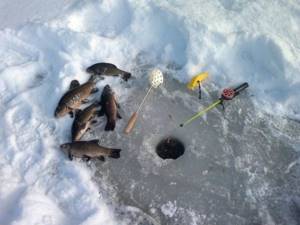
It also happens that the fish goes for one bait in the morning, and in the evening for a completely different one. Therefore, it is recommended to stock up in full and only then go fishing.
You can try using a mealworm as bait.
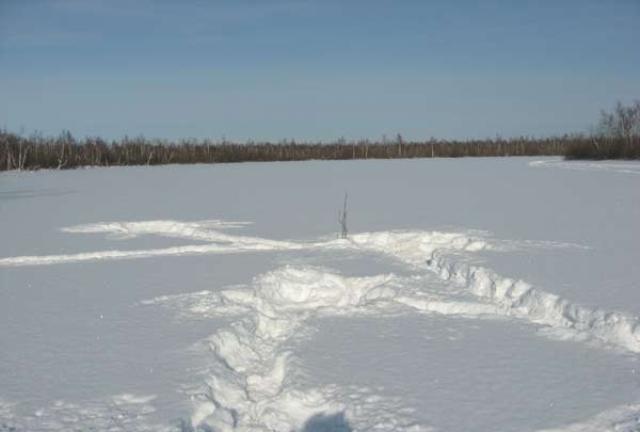
Tackle and tactics for catching tench in winter
To catch tench, winter fishing rods with a nod are used. Catching tench with winter fishing rods that are equipped with a bite alarm such as a float is less successful. Rod and reel make no difference, the main thing is that you are comfortable.
The fishing line is used no thicker than 0.12 mm. Otherwise, you risk alerting the fish and not seeing the long-awaited bite at all. In the cold season, the water is as clear as possible and using rough gear is unwise.
It is advisable to have several winter fishing rods in your arsenal - about 5 pieces, maybe more. The fact is that the best tactic for catching tench in winter is to use active play with one rod and inactively fish with several others. Tench can bite on any of these fishing rods, but if the tench suddenly likes the active bait, you won’t go wrong. In addition, during active fishing with one of the fishing rods, your bait will not be missed by any other passing fish, and an additional catch is always nice.
For active fishing, jig tackle is used with bloodworms attached to it. Rods for inactive fishing are equipped with a dung worm, the favorite food of tench. The equipment for worm fishing in winter is similar to summer equipment - a regular shotgun weight with a leash on which a small hook is located. It is better to catch the worm entirely so that it is clearly visible to the tench.
Typically, anglers who hunt tench every winter drill a hole half a meter apart from each other in an arc, as if in a semicircle. This makes it easier to have all the gear in sight and notice a bite on any of them. It is important to calculate the number of gears that you can keep track of. Usually this is 5 winter fishing rods, less often - 7-8. Although, often the tench hooks itself, and then timely hooking is not so important, but still, having noticed a bite, it is better to immediately hook it so that the tench sits well on the hook and does not come off it when fishing. You can’t rush, so that the tench doesn’t tear the thin tackle. Very often in winter you come across trophy tenches, so fish out the tench carefully, without haste, and always have a hook with you in case the tench does not fit into the hole.
Choose a place and time
Before you go fishing for tench, you need to decide on the fishing location. The difficulty is that the fish are not schooling and prefer to stay alone. If there are places where it is constantly caught, this indicates that there is a lot of food there.

In small rivers, tench are found far from the shore. Most often, fish choose bays and creeks in lakes, ponds and rivers.
Tench choose to live on a hard bottom with a small layer of silt. The thing is that horsetail prefers to grow here, and fish are used to wandering among it in search of food.
The best time for fishing is in the morning before 10 o'clock or before sunset. The bite can vary - be sluggish and slow, or vice versa - decisive and sharp. In this case, the tench will try to leave the hook in any case. In view of this, there is no need to rush into hooking!
The bite may be affected by changes in weather. If the atmospheric pressure is low, you may not expect a good catch. Warm and cloudy weather is most favorable.
Features of fishing for tench in winter
With the onset of freeze-up, the tench fish leaves the coastal overgrown areas and moves to depth or enters existing bays. For wintering, it chooses deep areas with abundant bottom vegetation. Tench live at the very bottom in winter and do not rise to the surface even during thaws. It is at the bottom that the main food supply for fish is located: representatives of zooplankton buried in the silt. The tench finds their location using sensitive whiskers, which play the role of a natural, very sensitive locator. The tench is protected from freezing and lack of oxygen by a jelly-like shell, which abundantly covers its entire body.
The most successful fishing for tench in winter is on the first and last ice. But if you have enough patience, you can catch the desired prey in January. Much depends on the region in which the tench lives. Good signs for targeted winter fishing are:
• Stable temperature – up to 1-5 degrees below zero;
• Sunny day;
• Light wind up to 2 m/s or complete calm;
• Stable atmospheric pressure.
If you know for sure that there is a tench in the reservoir, then you can start searching for it. On a large river and large lake, a fishing sonar should be used. In its absence, you need to pay attention to areas with islands of dying vegetation protruding above the ice surface. Bottom depressions with lush underwater vegetation and a thin layer of silt are typical habitats for tench in winter.
Features of catching tench in winter
Today we offer the topic: “peculiarities of catching tench in winter” from professional fishermen. We tried to cover the topic as fully as possible. You can ask all questions in the comments after the article.
Not everyone knows that you can catch tench not only in open water, but also from ice in winter. There is an opinion that this fish, like crucian carp, buries itself in the mud and spends the winter in a daze. In fact, everything is completely different and catching tench in winter is a winning business.
If there is such a tackle that can be used to catch tench in winter, it is a jig. Previously, there were only small rods, and therefore the fish caught on them were small. Now every angler has the opportunity to show off his catch, as such baits have become larger. They are silver in color and take a horizontal position in the water, which gives a very comfortable hook position.
One of the features that can be noted is the large coil. The thing is that tench lives at great depths, so there should be enough fishing line. Accordingly, the coil must be rather large.
It is important that the rod is durable. The tench begins to kick when you lead it closer to the surface. Due to this, the risk of rod breakage increases. The same can be said about the fishing line, it must also be strong. Well, if there is a nod, it will become an additional assistant for the fisherman.
Tench prefers cake as bait. The main bait is usually an earthworm. But it is not prohibited to fish for maggots. Sometimes the fish goes on bread soaked in anise drops.
It's best to experiment. To do this you will need 2 hooks with different baits. Each has its own hook. This way you can easily determine what tench prefers.
It also happens that the fish goes for one bait in the morning, and in the evening for a completely different one. Therefore, it is recommended to stock up in full and only then go fishing.
Before you go fishing for tench, you need to decide on the fishing location. The difficulty is that the fish are not schooling and prefer to stay alone. If there are places where it is constantly caught, this indicates that there is a lot of food there.
In small rivers, tench are found far from the shore. Most often, fish choose bays and creeks in lakes, ponds and rivers.
Tench choose to live on a hard bottom with a small layer of silt. The thing is that horsetail prefers to grow here, and fish are used to wandering among it in search of food.
The best time for fishing is in the morning before 10 o'clock or before sunset. The bite can vary - be sluggish and slow, or vice versa - decisive and sharp. In this case, the tench will try to leave the hook in any case. In view of this, there is no need to rush into hooking!
The bite may be affected by changes in weather. If the atmospheric pressure is low, you may not expect a good catch. Warm and cloudy weather is most favorable.
The technique for catching tench is quite simple.
- Choose a body of water that still has last year's vegetation.
- Next, a hole is drilled in a semicircle.
- It is necessary to make another 4–6 such holes, the distance between them should not exceed 1 meter.
- Accordingly, you will need 5–7 identical fishing rods.
Fishing goes on all fishing rods at once. The fishing line you need is 0.12 mm, the hook and crusher are medium.
The first fishing rod will be equipped with a jig - it is used as bait. The rest, except the last one, will be baited with a worm. The last fishing rod comes with bait - bloodworm.
A nod acts as a signal. In this case, there is no need to constantly monitor the fishing rods.
Catching tench in winter is not only possible, but also necessary. The main thing is to choose the right place for fishing and follow the tips given above. By using several fishing rods, you will certainly achieve a good result.
This species belongs to the carp family, and also has pronounced characteristic differences. However, in terms of taste, it is in no way inferior to its counterparts; moreover, many connoisseurs and gourmets rightfully give it a high rating. The girth of the fish reaches up to seventy centimeters, while its weight can be seven kilograms. Therefore, for an avid fisherman, winter tench fishing is of particular interest. In terms of color and body structure, it has much in common with the ide: the tail is short, rounded fins, the upper part of the body is dark green, the main color contains a yellow tint.
Tench is a fairly common fish, so you can find it almost throughout Russia. It lives both in stagnant water (all kinds of lakes or even a forest pond) and in river basins flowing into the sea. And this applies to both the southern and northern parts of our country. When fishing for tench in winter, several factors must be taken into account:
- The most increased activity occurs in early December, as well as mid and late February. Any thaw can be successful.
- The optimal fishing time is a sunny and clear day, without strong gusts of wind.
- To escape from predators, this representative of the ichthyofauna prefers coastal zones where underwater flora is located.
- It is better to choose average depths from two to four meters. Desolate lakes with thickets of reeds in the summer, which then fall to the bottom, are ideal.
Photo 1. The coastal steep zone is a promising place to search for tench.
Winter fishing for this representative of the carp family is quite a pleasant experience. To do this, use a tackle equipped with a special signaling device at the end of a small rod, called a “nod”. A float can be used, but is not necessary. When a jig without a nozzle is used for fishing, there is no need for a float at all. In another case, it can be placed, because during “passive” fishing with live bait (in the absence of playing with a jig), it will be easy to determine the bite.
Photo 2. Universal winter fishing rod.
The length of the rod is not a fundamental point, nor is the method of winding the fishing line. You can use a small reel or any other mechanism. The main thing is that it is convenient, and there are no problems with quick hooking when biting and fishing for fish. The diameter of the fishing line is suitable 0.12 - 0.15, depending on the quality, variety (twisted or not), manufacturer, and the size of the tench, in relation to the specific area where it is caught.
Fishermen with some experience should pay attention to thin “gossamer” fishing lines from reputable manufacturers, for example:
- "Yotsuami" (Japan);
- "Morris" (Japan);
- "3M Company" (USA);
- Bayer (Germany);
- "Aqua" (Russia).
Recently, technologies for the manufacture of these products have advanced significantly. It became possible to use fishing line in the range of several thousand fractions of a millimeter. But only an experienced person can do this, and a beginner will most likely have problems.
To fish as efficiently as possible, it is better to have at least 3 - 5 fishing rods, most of which will be equipped with floats. You can also use a special mechanism called a “flag”. It is used if there is no visual overview of all gear, since without it the bite will not be visible.
Whether a tench bites a worm or is it better to use another bait will largely depend on both the fishing technique and the preferences of the fish itself. It is necessary to pay attention to the prevalence of a particular bait in a particular area. In other words, if there are few bloodworms in reservoirs in a certain area, then it is better not to use them as bait. Artificial bait (jigs) can be easily combined with an animal, which is most effective in our case.
The color of the jig should also match the common bait. The opportunity to experiment is always allowed here. Each fisherman has his own ideas and methods, which appear over years of practice. A certain frequency of the jig's stroke amplitude creates a peculiar pattern - such an interesting play of the bait is what makes the fish bite. In essence, these are frequent and soft movements of the hand up and down, however, this method has many features. Many books have been written on the fishing technique for the specified tackle with a jig, where you can familiarize yourself with it in more detail.
You can catch tench well in winter when using the following baits:
- river bloodworm;
- earthworm;
- maggot;
- white bread, pre-treated with anise drops.
Cake is most often used for feeding. It’s good if you have special gear for this in your arsenal. Especially when the pond is deep and has little current. The simple mechanism is a round shape made of metal, which is attached to a thick fishing line. Small holes in the body allow you to gradually feed the fish as the cake gets wet.
Baits for fishing
The more difficult it is to catch, the more interesting it is to catch freshwater tench. In its natural environment, it likes to hide in the thickets of a quiet backwater somewhere near the bottom. There he feeds on what he finds among the silt, digging it to a depth of 8 - 10 centimeters. The simplest microorganisms, insects, which, we recall, are also used when keeping fish in an aquarium, invariably replenish its menu. However, he is not against green vegetation, which abundantly covers closed bodies of water near the shores. This can be either growing algae, grass, young shoots of reeds, reeds, or their remains that settle below, detritus. The share of green feed is up to 40-60%.
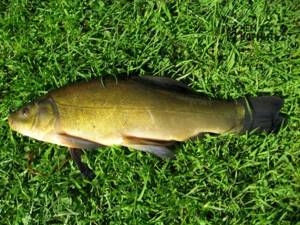
Tench fishing is most productive in spring and summer. After a winter diet in the spring, he begins to actively replenish weight loss, so the main thing is to make the right bait. There are many options here. Moreover, as experienced fishermen say, tench also takes bait prepared for crucian carp, rudd, and other fish. However, among the entire rich catch, only one specimen is often found.
To catch this cautious representative of cyprinids, you need to imagine where it is found in a particular body of water and prepare a bait mixture in advance. Despite the fact that stores offer ready-made dry bait specifically for this fish, avid fishermen prefer to prepare it themselves. Firstly, it is cheaper, and secondly, factory baits are not adapted to any specific area. Thirdly, the mixture may contain components that repel fish with their smell or color. The flavorings used in them are not always of good quality.
Economic importance of tench
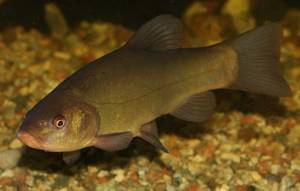
As an object of recreational fishing, tench is not very important. Firstly, this fish is so lazy and inactive that you can catch it with a fishing rod or in a net only if you accurately guess the habitat of a particular individual. Typically, tench live on a small patch of river (lake) bottom, which they leave only for spawning. Secondly, tench lives in the same reservoirs as carp, crucian carp, bream and other popular freshwater fish, which are much more susceptible to sport and industrial fishing.
As for targeted breeding under controlled conditions, here too tench plays a secondary role. The same carp and silver carp are more suitable for breeding in ponds, reservoirs and river dams. However, tench has one important advantage, which still makes it interesting for artificial breeding. Since this fish can live in a body of water with a low oxygen content, breeding tench fish is possible where other commercial fish cannot be bred.
Also, the advantages of tench as a commercial fish include its lower susceptibility to diseases. Unlike other commercial fish, in particular carp, tench does not suffer from dactylogyrus, rubella and other parasites.
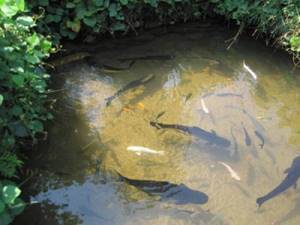
At the same time, tench meat is known for its excellent taste. It is very juicy and slightly sweet. That is, problems with the sale of products will not arise in any case.
